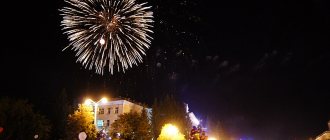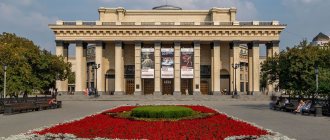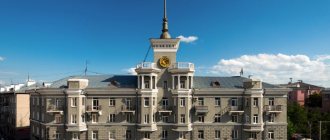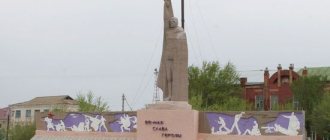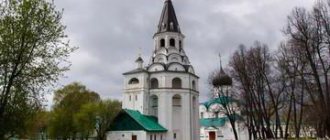Vologda and the Vologda land are wide, calm rivers, bright lakes and endless dense forests. The natural resources of the region attracted enterprising Novgorodians here back in the 12th century, who, pushing aside the local Finnish tribes, set up their fortified settlements along the banks of rivers and lakes. One of them, founded on the right bank of the Vologda River, which meant “bright water” in the Finno-Ugric language, later became the city of the same name and the center of a vast and rich northern region, which played an important role in the history of Russia.
Vologda history of the city.
The founding date of the city (1147) was first discovered by the Vologda historiographer A. Zasetsky while studying the life of the locally revered miracle worker Gerasim. The advantageous geographical location of Vologda at the base of the waterways from the center of Rus' to Primorye and Siberia - to fabulously rich and therefore always tempting lands, initially did him a disservice. For more than two centuries, Vologda was the scene of a fierce and bloody struggle between the Novgorodians, first with the Tver and then with the Moscow princes, and was repeatedly raided, but each time it rose from the ashes.
Vologda history of the city.
By the 15th century, the Moscow princes won this struggle, and Vologda linked its fate with Moscow for many centuries. The city becomes a major commercial, industrial and cultural center of the Moscow State. The 16th century was the time of economic and cultural prosperity of Vologda. The city not only holds a key position in domestic trade, but also becomes the most important link in the international trade of Rus' with England and Holland.
Theater for Young Spectators
The doors of the theater were first opened to spectators in 1976. Although the troupe did not have its own building for the first 4 years, all performances were held in schools and other cultural institutions.
In 1980, the theater received a building. With the arrival of director Granatov in 1985, the Youth Theater began a new bright stage. Already the first production, entitled “The Lizard,” evokes a storm of positive emotions and reviews.
In 1991, a school of dramatic art was opened at the theater. Today it is a theater whose productions are intended not only for children, but also for teenagers.
Youth Theater address: st. Oktyabrskaya, 2.
Vologda history of the city.
In the second half of the 18th century, as a result of the reforms of Catherine II, Vologda became a provincial city and the administrative center of a vast territory, stretching in a long strip from southwest to northeast, from the Novgorod borders to the Ural Mountains. At the same time, the coat of arms of Vologda and the general plan for its construction were approved.
Vologda wooden architecture
In Vologda, not only the city's wooden buildings have been preserved; there are many unique houses and their condition is often quite decent. These houses are included in the list of attractions of Vologda and are a must see!
By the beginning of the 21st century, there were from 105 to 170 wooden architectural monuments in Vologda, dating from the 18th – 20th centuries. These are noble, merchant, and bourgeois houses, made in such architectural styles as classicism, empire and modern.
Many examples of Vologda wooden architecture can be found near the Kremlin. There are many such houses on Leningradskaya Street .
Also take a look at Blagoveshchenskaya Street (previously called Klara Zetkin). this is a real treasure trove of wooden houses in Vologda. On this street there are several outstanding monuments of wooden architecture and a monument to a carved palisade.
Vologda attractions
In the historically established layout and development of Vologda, it is customary to distinguish four main parts: the City, the Upper and Lower Posads and the Zarechye. The so-called City is the territory of a former fortress from the times of Ivan the Terrible. Its borders run along the line of modern streets: Mira, Oktyabrskaya, Leningradskaya, and the river bank. You should start your acquaintance with Vologda with Cathedral Hill. The architectural ensemble of cathedrals and the Bishop's Court has played the role of a historical center for centuries.
Center for Folk Crafts "Carved Palisade"
Naturally, an establishment with such a name is located in the building corresponding to it.
Center for Folk Crafts "Carved Palisade"
The interior matches it too. The chairs in the rooms are decorated with carvings. Antique photographs, embroideries and drawings are hung on the walls. The lampshade above the table is also covered with a lace scarf. On the table are the tools necessary for teaching children how to weave lace and birch bark, wood carving, and making dolls and clay toys.
The center preserves and develops the traditions of Vologda craftsmen - carpenters, carvers, embroiderers, potters, blacksmiths. On weekly “Soulful Thursdays”, masters of folk art gather in the house and share their experiences and ideas.
“Carved Palisade” is the organizer of the annual festival “Voice of Crafts”, held on the territory of the former Vologda Kremlin.
Address: st. Zasodimsky, 5. Opening hours: 10–19. Directions: by buses No. 7, 8, 11, 13, 27, 29, 32 to the Leningradskaya Street stop.
St. Sophia Cathedral in Vologda
St. Sophia Cathedral (1568-1570) - the first stone building of Vologda - a five-domed, six-pillar, three-apse temple. The Assumption Cathedral of the Moscow Kremlin was chosen as a model. In 1686-1687, that is, a hundred years after its construction, the cathedral was painted with frescoes by an artel of isographers from Yaroslavl, headed by Dmitry Plekhanov, as evidenced by the inscription on the inner wall of the temple. The currently existing iconostasis, the third in a row, was made in the first half of the 18th century. Along the northern and southern walls are the burial places of twelve bishops.
Governor's House
The Governor's House is one of the main architectural attractions of Vologda. The 18th century building attracts the gaze of all passersby. The beautiful facade with graceful window openings and columns at the entrance looks very solemn. Today, this building houses the administration of the President of the Russian Federation. The hall and reception area are also used for ceremonial registrations of marriages. The rest of the building is accessible for inspection only by government officials and a few visitors; tours of the Governor's House are not available.
Bell tower of St. Sophia Cathedral in Vologda
The belfry of the St. Sophia Cathedral was built in 1869 by order of Bishop Palladius, who believed that the cathedral bell tower should be the tallest in the diocese. Now the Vologda bell tower is only five meters lower than the Ivan the Great bell tower in the Moscow Kremlin
. from the upper platform, located at an altitude of 73 meters, there is a wonderful view of the city, the river and the Spaso-Prilutsky Monastery looming in the distance. The main attraction of the Vologda belfry are the bells. Twenty-five of them have survived. Before the revolution in Russia there were about two thousand complete sets of bells, only five remain, including in Vologda.
Museum "Vologda Link"
In Tsarist Russia, one of the places where prisoners were exiled was Vologda. In modern times, or rather in 2007, in a wooden house on the street. Maria Ulyanova opened a museum dedicated to this phenomenon. In the building where the museum is opened, in 1911-12, the future leader of the Soviet people, known to us as I.V. Stalin, lived for several months in 1911-12. He was also in exile in Vologda. The exhibition tells about famous political prisoners and their activities.
Bishop's courtyard in Vologda
The bell tower is directly adjacent to the Bishop's Court, the residence of the Vologda bishops, which since the 19th century has received a stable name - the Vologda Kremlin. An irregular quadrangle of high stone walls with towers at the corners was erected around the Bishop's House in 1671-1675 under Bishop Simon. Even now, centuries later, the architectural complex of the Kremlin gives the impression of a mighty fortress. Since 1991, the summer theater festivals “Voices of History” have been held here.
Museum "World of Forgotten Things"
In this museum you will find an exhibition dedicated to pre-revolutionary Vologda, the culture and life of various segments of the urban population of that time. The halls display 19th-century interiors and various items common in pre-revolutionary houses. The extensive collection is located on three floors, it consists of old photographs, family heirlooms, furniture, and interior items.
Resurrection Cathedral in Vologda
In 1771-1776, on the site of the dismantled north-eastern tower of the Kremlin, a warm cathedral of the Resurrection Cathedral in the Baroque style was built. The cathedral building is two-story, rounded in plan and covered with a dome. The temple is adjacent to four semicircular porches with turrets, an altar on the east, and a refectory on the west. On the lower floor of the Resurrection Cathedral there was a single-pillar church covered with vaults. In 1824, on the occasion of the arrival of Emperor Alexander I in Vologda, the main entrance to the cathedral was decorated with a portico with four columns of the Tuscan order and a pediment.
What to see depending on the time of year
Vologda has a moderately cold climate. It often rains here and snows in winter. the hottest month, July, is accompanied by the heaviest precipitation (78 mm). The average July temperature is 16.9°C. Despite the rainy summer, tourists prefer to come here in the summer. A local seasonal attraction is the city beach.
Vologda city beach
The city beach of Vologda is the only organized place for a beach holiday. Natural river sand is brought to this beach. Meadows for picnics were created here, gazebos and sun loungers were built. Lifeguards are on duty on the beach from morning to evening during the swimming season. There are also changing cabins, toilets and trash cans on the beach.
Several times a season, a black flag is hung over the beach - a signal that swimming is prohibited. This happens during storm warnings and bad weather conditions.
Information for tourists:
- the beach is located on the territory of Mira Park;
- opening hours: daily, around the clock, but rescue towers operate from 9:00 to 21:00 during the swimming season;
- Entrance to the beach area is free.
Video: beach in Mira Park
Around the Bishop's Courtyard.
Over time, the construction of commercial and residential buildings has resumed around the Bishop's Court. Several stone churches were erected here in the 18th century: the Church of the Intercession of the Mother of God “at the market” (1778-1780), the Church of the Kazan Icon of the Mother of God “in the swamp” (1760) and the Church of St. Nicholas the Wonderworker “on lime” (early 18th century), later reconsecrated into the Church of St. Alexander Nevsky.
Vologda. Upper landing.
Verkhny Posad is the most ancient part of Vologda, a unique symbol of which is the obelisk in honor of its 800th anniversary, erected in 1947 on the former Lazy Square on the site of the unpreserved Church of the Resurrection. The decoration of Upper Posad, and the entire city, are stone churches, which replaced wooden ones in the 17th century. Thanks to the verticals of churches and bell towers, the flat and monotonous topography of the city acquired dynamism and expressiveness.
Monument to the letter "O"
Vologda residents are okaya in conversation. A monument to this feature of the townspeople in the form of a metal letter was erected in 2012 in the city park on Cathedral Hill near the Kremlin Square. The height of the capital letter “O”, decorated with traditional northern ornaments, is 2.5 m.
Monument to the letter "O"
The idea of installing the original monument belonged to students of the Vologda Institute of Business, after which a competition was announced among students of the Vologda school. The winning project was brought to life with a two-week effort by six blacksmiths. The monument was opened on the city day, when the 865th anniversary of Vologda was celebrated. Over the past years, a tradition has developed of photographing newlyweds inside a letter that acts as a frame.
Gorne-Uspensky convent in Vologda.
Behind the monument to the 800th anniversary of Vologda in the depths of the street. Burmagins is the Gorne-Uspensky convent. In ancient times the area surrounding it was called “Mountain”, hence the name of the monastery. The Assumption Cathedral (1692-1697) - the main church of the monastery - is small in size and resembles ordinary parish churches, which is what it currently is. On Pobedy Avenue there is an elegant church of St. Constantine and Helena (1690).
Vologda. City development.
Vologda, like many other ancient Russian cities, grew and developed due to the settlements. With the cessation of hostilities and simple predatory raids, the ancient city itself began to lose its purpose as a refuge. In the second half of the 18th century, the administrative center of the city moved to a younger and dynamically developing part of the city - Nizhny Posad.
Vologda Zarechnaya part
The part of the city beyond the river offers a magnificent panorama of the embankment, where vertical churches are interspersed with stone buildings, mainly merchant mansions. The festively decorated Church of the Presentation, built in 1731-1735, is distinguished by its extremely rich brick “pattern” and the extraordinary richness of ceramic decor. Next to the temple there is a two-story mansion - the Kuskova House - one of the earliest civil stone buildings, the date of its construction is 1777.
Church of St. Nicholas the Wonderworker
Somewhat away from the embankment rises the Church of St. Nicholas the Wonderworker “in the Vladychnaya Sloboda”, which since ancient times belonged to the Vologda archbishops. This is the largest temple in size after the St. Sophia Cathedral and one of the oldest in Vologda, built in 1669 by “posad people”. In the southern part of Zarechye, on the bank, downstream of the Vologda River, in the second half of the 17th century, the Church of the Transfiguration “in Fryazinov” was erected. Its architecture was distorted by later reconstructions: only the central drum remained from the five-domed structure, but the tented bell tower adjacent to the west, light and openwork, retained its original appearance.

